Though stairways are inherently hazardous, there are steps you can take to reduce the chance of a fail. If the stairs lack the vertical riser boards that close off the gaps between steps, for example, you can fashion some yourself and nail them to the boards that support the steps. and to prevent slips, cover the steps with nonskid wax or paint, low-pile carpeting, or rubber safety strips. On the pages that follow are two of the most useful techniques for increasing stair safety: tightening up a loose newel post—the large upright post at the base of the stairs that supports the railing—and installing a second handrail to the wall beside the stairs.
Securing Loose Posts: The method for strengthening a newel post depends on the stairway design. The presence of a bullnose, a rounded, ornamental bottom step that ex tends beyond the width of the stair case, allows you to tighten the newel from below the floor (below). Otherwise, you must determine how the steps are held in place. Most older stairways support the steps with carriages, 2-inch boards at the sides of the staircase. The steps are nailed through their faces to the carriages, which are them selves nailed to boards called stringers, which in turn are nailed to floor joists at the top and bottom of the stairs. But in many newer stairways, the steps simply rest in notches cut into the stringers themselves. Examine the ends of each step for nailheads or spots of wood putty covering set nailheads. These are the telltale signs that the steps are nailed to carriages, and that you can secure the newel post by screwing it to the outer carriage. If you find no evidence of nailing, the steps are set directly into the stringers. In this case you must tighten the newel by either re placing its screws with new ones of larger diameter or adding 1-inch chair-leg braces.
A Helping Handrail: Adding an extra handrail is advisable only for stairways at least 36 inches wide; it would make a less generous stair way too narrow. Choose handrail stock that measures no more than 2 inches across, since wider rails are difficult to grasp. In addition to a long, straight section of handrail the length of the staircase, buy two right-angle handrail sections called level quarter-turns and two wood end plates called rosettes. Hard ware you’ll need includes metal mounting brackets and rail bolts for joining the pieces.
With firm handholds in place, the stairs are as safe as possible for everyone except crawling or toddling children. To help protect them from a tumble down the stairs, close off the top of the staircase with an expanding gate.
TOOLS:
- Combination square
- Hammer
- Electric drill
- Spade or Forstner bits (3/8”, ¾”, 1”)
- Twist bits (2/32, 11/64, 7/32, ¼, 5/16”)
- Chalk line
- Socket wrench with 1/2” socket
- Electronic stud finder
- Miter box
- Saw
- Framing square
- Adjustable wrench
- Nail set
MATERIALS:
- Nails
- Wood dowels
- Lag screws (5/16” x 3” and 5/16” x 4”) and washers
- Chair-leg braces (1”)
- Wood glue
- Handrail mounting brackets
- Handrail
- Handrail quarter- turns
- Handrail rosettes
- Rail bolts
- Flat-head wood screws (1½” No. 8)
- Finishing nails (2”)
- Wood filler
- Child safety gate
- Round-head wood screw (2”)
- Hollow-wall anchors
SAFETY TIPS: Wear goggles to protect your eyes when drilling and hammering.
Steadying a Loose Newel Post
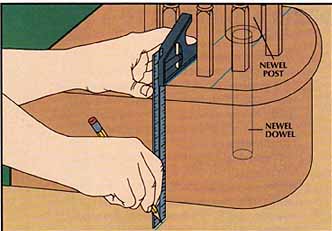
Reinforcing a post in a bullnose.
• Use a combination square to draw parallel lines across the step touching the newel. Then transfer the lines to the floor on each side of the bullnose .
• Center a nail between each pair of marks on the floor and drive it through the flooring.
• Slide the combination square’s ruler through the base and stand it on the floor with the edge of the ruler touching the nailhead. Measure from the ruler to the newel post and add one-half the post diameter.
• Working underneath the floor, use this measurement and the nail points to find the newel dowel’s center.
• Drill a 7/32-inch pilot and a 5/16-inch shank hole through the flooring and into the end of the dowel for a 5/16- by 3-inch lag screw, then drive the screw with a 1/2-inch socket wrench.
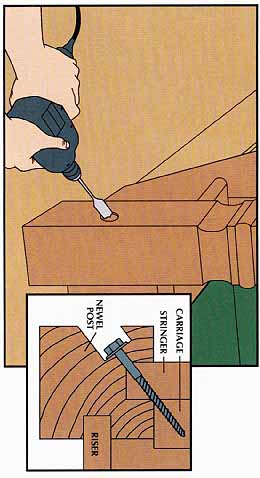
Bolting a newel to a carriage.
• At the center of the newel post, 4 inches above the floor, bore a countersink hole toward the carriage. Drill ¾-inch deep with a 3/4-inch spade bit or Forstner bit.
• Drill a 7/32-inch pilot hole and a 5/16-inch shank hole for a 5/16- by 4-inch lag screw.
• Fit a washer onto the lag screw and drive it into the carriage with a socket wrench (inset).
• Plug the countersink hole with a dowel.
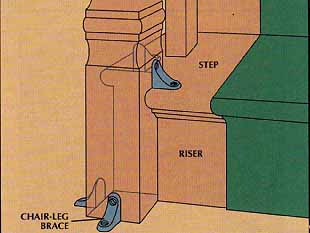
Bracing a newel post.
For greatest stability, brace as many sides of the post as possible.
• As a helper holds the post plumb, position a chair- leg brace on each side of the post and mark locations for screw holes.
• Drill pilot holes for the screws provided with the braces, angling the holes slightly away from the joint.
• Push the newel post from side to side and spread woodworking glue in any cracks that open between the post and the floor or bottom step.
• Screw the braces to the post, and allow the glue to set before using the stairs.
Adding a Handrail to a Stairway Wall
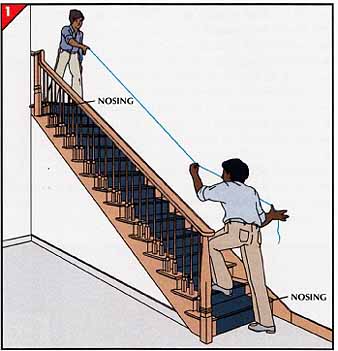
1. Positioning the brackets.
• Measure the vertical distance from the nosing of the bottom step to the underside of the existing handrail. Transfer the measurement, less the height of a handrail bracket, to the stairway wall above the bottom-step nosing and above the upper-landing nosing.
• With a helper, snap a chalk line between the marks.
• Use an electronic stud finder to locate the studs at the top and bottom of the stairs and every second stud in between. Mark their widths on the wall along the chalked line.
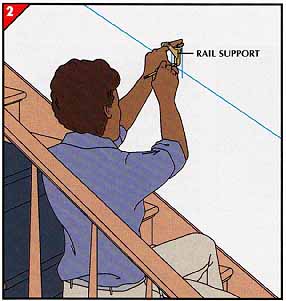
2. Securing brackets to the wall.
• Center a handrail bracket over each stud marked in the previous step, with the bracket’s bottom edge at the chalked line. Mark the screw hole positions on the wall.
• Drill pilot holes for the screws that come with the brackets, and screw each bracket to the wall.
• Measure and note the distance from the center of the rail support to the wall.
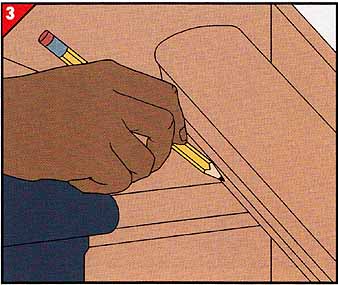
3. Fitting the handrail.
• Lay a length of handrail stock on the stairs against the wall and mark it at the bottom-step and upper-landing nosings .
• Cut through the stock at the marks, using a miter box to make square cuts.
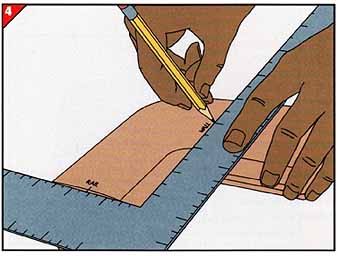
4. Trimming the quarter-turns.
• Mark a quarter-turn to identify the rail arm and wall arm.
• Subtract the thickness of a rosette, taken at its center, from the support- rail measurement made in Step 2.
• On one leg of a framing square, locate the mark that corresponds to this figure and align it with the center of the rail arm. Then draw a line across the wall arm along the other leg of the framing square.
• Cut the wall arm at this line using a miter box, then trim 1 inch from the rail arm so the handrail does not ex tend too far beyond the staircase.
• Mark and trim the other quarter-turn in the same manner.
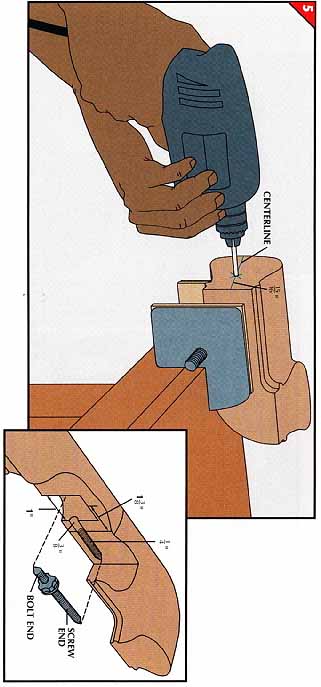
5. Joining the pieces. Before you begin drilling any of the
holes described in this step, secure the workpiece in a vise.
• Draw a vertical centerline on the rail end of each quarter-turn and mark a point on the line 15/16-inch from the bottom.
• Make identical marks on each end of the handrail.
• Mark the bottom of the rail 1 3/8-inches from each end.
• Drill a -1/4-inch hole 1 7/8-inches deep into each quarter-turn rail arm at the mark.
• Drill a 3/8-inch hole 1 7/8-inches deep at the points marked on each end of the handrail.
• Drill 1-inch holes 1½-inches deep at the marks on the bottom of the rail.
• Run the notched nut and washer of a rail bolt onto the fastener (inset).
• Use a wrench to drive the rail bolt’s screw end into the quarter-turn.
• Remove the nut and washer and fit the bolt end of the fastener through the hole at the end of the rail. Replace the nut and washer through the 1-inch hole in the bottom of the rail and tighten the nut with a nail set.
• Fasten the other quarter-turn to the other end of the handrail following the same procedure.
• Fill the holes in the bottom of the rail with a wood plug.
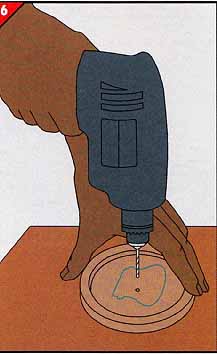
6. Joining the rosettes and handrail.
• Outline the end of a quarter-turn on each rosette.
• Drill two a 11/64-inch shank holes through the rosettes within the rail outline. Counterbore the holes on the backs of the rosettes.
• Mark the wall ends of the quarter-turns at the centers of the shank holes.
• Drill 3/32-inch pilot holes into the end of each quarter-turn at the marks.
• Fasten the rosettes to the quarter-turns with 1 1/8-inch No. 8 flat-head wood screws.
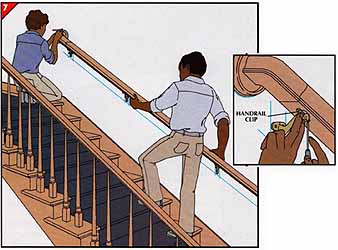
7. Installing the handrail.
• With a helper holding the handrail atop the brackets, mark the wall around the rosettes to establish the position of the rail.
• Then place bracket clips over the handrail brackets and mark the locations of their screw holes on the rail (inset).
• Drill pilot holes for the screws provided with the clips, and screw the rail in place.
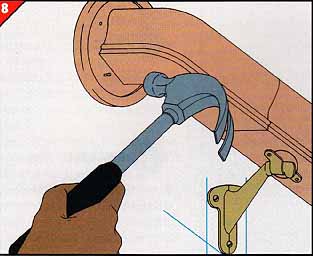
8. Fastening rosettes to the wall.
• Drill 3/32-inch pilot holes through the rosettes.
• Drive 2-inch finishing nails through the holes into the wall, and set the nails.
• Conceal the nailheads with wood filler.
Protecting Toddlers with a Safety Gate
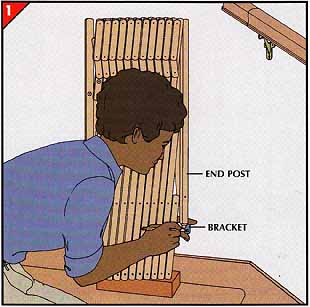
1. Attaching the gate.
• Set the gate on a scrap of 2-by-4 to keep it 1½-inches above the landing.
• Fit a bracket to the bottom of the end post of the gate and set this post against the wall or newel. Then mark a hole on the wall or newel for a bracket fastener.
• Attach the bracket with a 2-inch wood screw or a hollow-wall anchor.
• Set the gate in the bottom bracket and fit a bracket to the top of the end post. Mark a hole for the upper bracket and attach it with the gate in position.
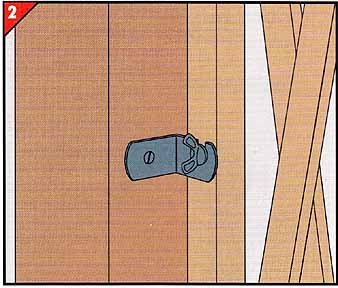
2. Installing the catch. If possible, mount the catch on the
stairway side of the gate, where a child can't easily reach it. Position the
catch so the gate must be lifted for opening.
• Attach the catch to the wall using a wood screw or hollow-wall anchor. Place the slotted catch shown here with the open end of the slot facing up.
• Then insert the bolt through the hole in the gate post, slip it over the slot in the catch, and secure it with the wing nut provided.
Previous: Fences
to Secure a Yard
Next: Childproofing
Storage Areas